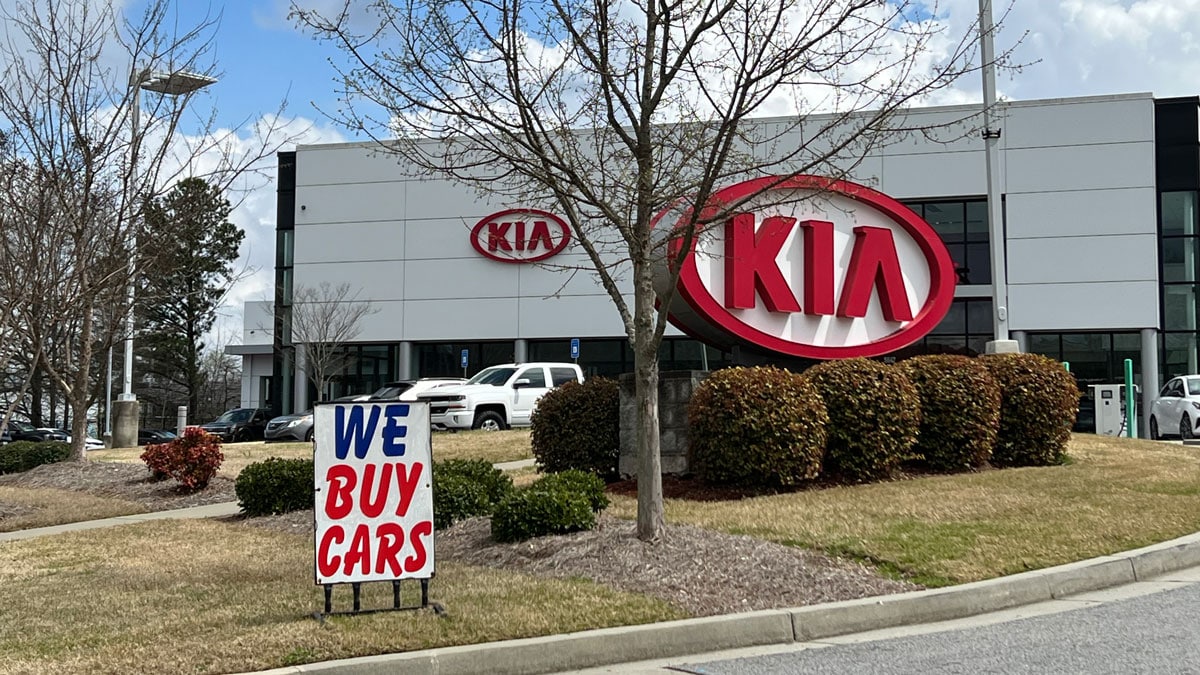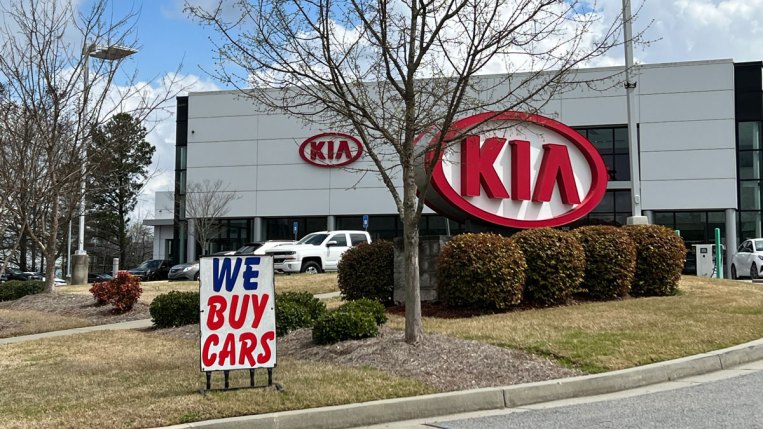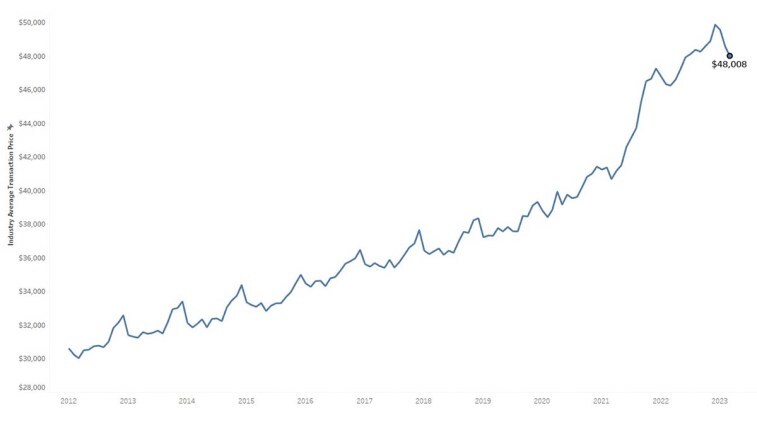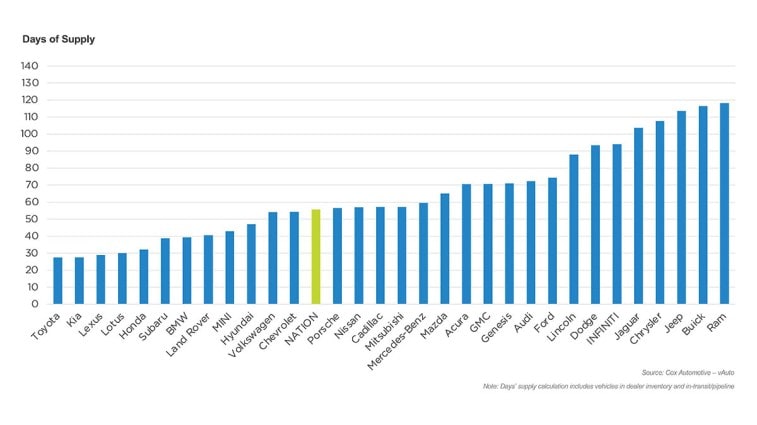Quick Facts About Car Prices
in the last several years, car shoppers grew accustomed to paying more than MSRP, or the manufacturer’s suggested retail price. They watched car prices rise steadily, with no end in sight. It left many shoppers scratching their heads, and the question our experts get most is, “When will new car prices drop?”
Now we can tell you that average transaction prices fell below MSRP for the first time in two years. While that’s great news on its face, car prices increased exponentially in the last three years.
In this story, we’ll explain how to navigate car buying, so if you’re in the market to purchase a vehicle, you’ll be equipped with the best information we know from our experts. We also dig deeper to answer the question about car prices dropping.
What Drives New Car Prices
According to Kelley Blue Book data, new car average transaction prices (ATP) dipped month-over-month in March at $48,008, down $515 from February. However, it’s the first time average transactions fell below MSRP in the past 20 months, and manufacturer incentives increased. More on that in a bit.
Still, we must caution that while these are signs to celebrate. Average transaction prices remain nearly 30{ca2182fc8fed51dc37b95061ee48b5056cde1176732b225548c54a0c0156d303} higher than in March 2020. That’s when the nation shut down due to COVID-19 and average transaction prices for new vehicles were $37,736.
The data show that higher interest rates for car loans and inflation continue to hurt new vehicle sales of less expensive models. Our experts said that strong luxury vehicle sales pushed up new vehicle prices. In March, car buyers paid an average transaction price of $44,182 for non-luxury vehicles. For luxury, they paid an average of $65,202.
“The latest transaction data from March reveals new-vehicle prices continued a downward trend through the first quarter of 2023,” said Rebecca Rydzewski, research manager of economic and industry insights for Cox Automotive, the parent to Kelley Blue Book. “Both luxury and non-luxury prices were down month over month. We’ve been anticipating transaction price declines as inventory has steadily improved and choice has expanded. More vehicles on dealer lots – and on their competitors’ lots – means dealers simply don’t have the pricing power they did six months ago.”
The average transaction for a new electric car in March was $58,940, a slight increase of $313 from last month.
Take a look at these typical factors affecting new car prices:
- Inventory availability
- Manufacturer incentives
- Dealer discounts
- Trade-in vehicle value
All four of those factors faced major disruptions in the last several years.
New Car Inventory Update
In the past several years, inventory fell to record lows, primarily driven by a worldwide microchip shortage. Without enough crucial microchips, which control everything from engine timing to navigation systems, automakers couldn’t build cars as fast as they wanted. Despite recent improvements in car inventory, the chip shortage continues to linger for some carmakers and certain models. It has some manufacturers like Ford rethinking inventories for the long haul, even when the chip shortage fully resolves.
Dealerships measure their stock of new cars to sell in a metric called “days of inventory” — how long it would take them to sell out of new vehicles at today’s sales pace if the automaker stopped building new ones. Last year, inventories fell to just one week. By the end of January, many brands’ inventory was 68{ca2182fc8fed51dc37b95061ee48b5056cde1176732b225548c54a0c0156d303} higher than the year-ago period. However, some carmakers remain in recovery mode.
Which Automakers Have the Most Vehicles?
Cox Automotive data analysis of vAuto shows that brands like Ram, Buick, Jeep, Chrysler, Jaguar, Infiniti, Dodge, and Ford offer plenty of new car stock, while others’ inventory levels still sit well under normal, including Toyota, Kia, Lexus, Lotus, Honda, Subaru, BMW, and Land Rover.
RELATED: Is Now the Time to Buy, Sell, or Trade-In a Car?
Overall, inventory continues to improve. At the end of March 2023, the auto industry had a 56 days’ supply of vehicles to sell. It’s inching closer to what’s considered a normal supply of inventory, or 60 days’ worth by historical standards. At one point in 2019, automakers stocked a 95 days’ supply of vehicles.
And the lower the price category, the tighter the supply. If a shopper wants a car under $20,000, those are the toughest to find, with a 24-day supply of vehicles to sell.
Vehicle Incentives Are Coming Back
For the first time in a year, carmakers used more incentives to attract buyers. According to Kelley Blue Book, carmakers spent 3.2{ca2182fc8fed51dc37b95061ee48b5056cde1176732b225548c54a0c0156d303} of the average transaction price on incentives meant to move vehicles. Incentives were an average of about $1,500. Luxury vehicle incentives reached 6.7{ca2182fc8fed51dc37b95061ee48b5056cde1176732b225548c54a0c0156d303} of average transaction prices.
“With some brands and segments nearing too-high levels of inventories, we are seeing discounts and incentives increase,” said Charlie Chesbrough, a senior economist with Cox Automotive. “We are beginning to see more incentives, particularly leasing deals, crop up.”
When automakers build up an oversupply of cars, they discount the vehicles to get them off dealer lots. For the past several years, carmakers and dealerships showed no glut of cars to sell, and they barely discounted. Now, supply is starting to build up again, partly because of higher interest rates on car loans.
In March, consumers paid $171 less than MSRP. Last year, they paid nearly $1,000 more. Car incentives remain low compared to pre-pandemic years. However, as inventory improves, incentives are trending upward.
“Incentives and inventory tend to move in tandem – when one moves up, so does the other,” said Rebecca Rydzewski, research manager of economic and industry insights for Cox Automotive. “Right now, in-market consumers are finding more inventory, more choice, and dealers more willing to deal, at least with some brands. Yet, even as deals improve, unfortunately, auto loan rates remain very high, ultimately making new-vehicle affordability an issue for many households.”
It’s a Great Time to Shop Around Your Trade-in
Trade-in value is the last factor driving prices. A lack of used vehicles is pushing prices up again.
“The supply of used vehicles at dealerships is at its lowest point in our data, which goes back to 2019,” Chesbrough said.
That means it’s a great time to trade in your vehicle. Automakers scaled back production for several years after the 2008 recession. That leaves the higher-mileage, older cars dealers sell for less than $20,000 particularly hard to find now.
In other words, consumers trading in a 2018 Honda Civic will be much happier with the trade appraisal than those trading in a 2021 Jeep Grand Cherokee.
Shoppers should also be prepared to shop their trade-in around. It’s slightly more complicated to pull off, but selling your old car to one dealership may make sense, and buying your new car from a different one if the final invoice numbers work out better. Use the Kelley Blue Book Instant Cash Offer tool to shop your trade-in to dealerships near you. When you let the deals come to you, you can select the best trade-in offer for your situation.
Some Vehicle Prices Are Dropping
So, when will new car prices go way down? For some brands and some dealerships, prices began dropping. With other brands, like Honda, Kia, and Toyota, shoppers must be prepared to hunt and pay more for tougher-to-find vehicles. Those hard-to-find cars include the Toyota RAV4, Subaru Crosstrek, Toyota Camry, Subaru Forester, Honda CR-V, Honda Civic, and Kia Telluride.
Meanwhile, truck manufacturers stocked plenty of pickups. You’ll find plenty of Ram 1500s, Ford F-150s, and Chevy Silverados. GM idled two full-size truck plants to reduce inventory levels.
Economist Chesbrough said, “At this point, we don’t have a forecast on where new vehicle prices will end up, but we are seeing more discounts.”
Some Vehicles Are Still Selling at Markup Prices
While some carmakers and dealers with plenty of inventory provide incentives, others are still in short supply. It means some dealerships are still marking up vehicles.
At a Hyundai dealership in Greer, SC, Russ Heaps, a senior editor with Kelley Blue Book, went shopping for a personal vehicle, and the invoice included a markup of nearly $3,000 for a Kona SUV.
For example, consumers at Kia and Honda dealers paid between 3{ca2182fc8fed51dc37b95061ee48b5056cde1176732b225548c54a0c0156d303} and 6{ca2182fc8fed51dc37b95061ee48b5056cde1176732b225548c54a0c0156d303} over sticker prices in March.
What to Expect: Looking Ahead
But what if you desperately want a popular car that’s in low supply? Then you may need to be patient. Recent Federal Reserve interest rate hikes to rein in inflation make big-ticket purchases harder for everyone. The easing microchip shortage could resolve sometime in 2023. That will continue to increase the supply of vehicles.
Those trends could bring down the prices of even the most popular cars. But experts can’t put a date on when that will happen. Instead, shoppers should be flexible.
Cox Automotive data show that supply varies by market. Shoppers will find plenty of vehicles to buy in places like Minneapolis, Denver, Detroit, and Boston. But inventory remains tight in areas like Los Angeles, Atlanta, and throughout Florida, where extreme weather recently caused flooding in Ft. Lauderdale, destroying more vehicles and pushing more shoppers in an already tight market for new vehicles there.
While finding a low price on a new car is possible, it just may not be the car you thought you would buy. Or you may need to head to a smaller town outside of the big city where the competition isn’t as tough.
Editor’s Note: This article has been updated for accuracy since it was originally published.





More Stories
The Most Unique Custom Engagement Rings Made in London
Finding Driving Test Cancellations Made Easy: A Comprehensive Guide
Factors to Consider When Selling a Car